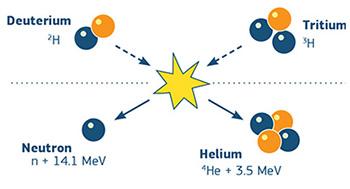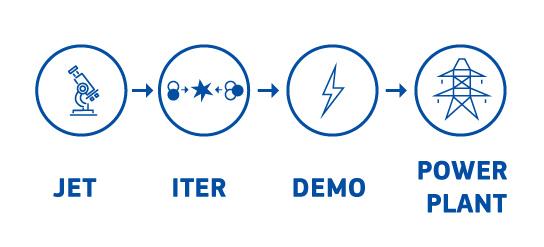
Energy, as we know and use it, is either provided from fossil fuels, nuclear power or renewable energy sources. As we raise our ambition to fight climate change, in the EU and the rest of the world, focus must shift towards cleaner energy options and the green energy transition is high on the political agenda. But investing in renewable energy sources alone might not be enough to guarantee a stable, safe and affordable energy supply.
ITER, the world’s biggest fusion machine project, could become a powerful contributor to reaching the clean energy needs of the future.
What is fusion?
Fusion is a nuclear reaction that powers the sun and stars, but it is also one of the most sought-after technological goals in the pursuit of clean energy. Fusion occurs when atoms are pushed together at extremely high temperatures and pressure, causing them to release vast amounts of energy by merging into heavier atoms. It is an incredibly dense form of energy, with abundant amounts of certain fuel – hydrogen isotopes. Fusion thereby carries the promise of providing safe, non-carbon emitting and virtually limitless energy, for hundreds of generations to come.
The catch? Fusion is very hard to achieve.
Firstly, recreating fusion on earth requires a temperature of 150 million degrees Celsius, which is 10 times hotter than the core of the sun. Secondly, while deuterium, one of the hydrogen isotopes, can be easily obtained from seawater, global resources of tritium – the other major ingredient - are scarce.

Since it was first discovered last century, scientists have tried to replicate the power of fusion on earth and, after considerable investment, we are now on the cusp of this becoming a reality. By the end of 2050, it is hoped that fusion should be able to produce electricity to the grid. In 50 years’ time, it will offer future generations a cleaner and safer source of energy – and one that has the potential to meet the majority of the world’s energy demands.Thirdly, huge magnets are needed for containing the plasma (a gas brought at several million degrees Celsius) in a vacuum-chambered fusion device, which is called “tokamak”.
Fusion history
The science and technology behind fusion has a long and rich history in Europe, starting in the early part of the 20th century when British physicist Francis William Aston discovered that net energy can be released by combining hydrogen atoms to form helium.
The development behind fusion research in Europe was accelerated in 1957 when the Euratom Treaty was signed and established a European atomic energy community.
The Joint European Torus (JET) - a ground-breaking achievement in fusion science - was approved by the European Commission in 1977. Using a tokamak design, this fusion research facility aimed at paving the way for future nuclear fusion grid energy. Since 1983, when JET was completed and its first plasma achieved, it has been working towards the holy grail of net energy gain – gaining more energy from the fusion process than is put in to keep it alive.
The successor to JET, the International Thermonuclear Experimental Reactor (ITER) aims to achieve just that.
The ITER project
ITER is a unique project, aiming to build the world’s largest fusion machine. By fostering innovation and international collaboration, the project creates economic growth and job opportunities, while putting the EU in the lead of global fusion research.
The construction work started in 2007 in Cadarache, in the south of France, on a 42 hectare site that today hosts the tokamak, several buildings, infrastructure and power supplies. ITER is one of the most complex engineering projects in history, as it will require millions of components to assemble the giant reactor that will weigh 23,000 tonnes.
The project stems from the ITER agreement, which was signed by 7 partners in 2006: China, Euratom (represented by the European Commission), India, Japan, South Korea, Russia and the USA. Together, they govern the ITER Organization, which is responsible for constructing and managing the project, and they all pool financial and scientific resources to it. Each partner has a domestic agency that manages its contributions; the EU’s agency is called Fusion for Energy and is located in Barcelona, Spain.
In addition to the ITER activities, the EU is also supporting fusion research, education and training activities through the EUROfusion consortium funded by the Euratom Research and Training Programme 2021-2025.
The (near) fusion future
ITER aims to produce 10 times more fusion power than the heating power put into the plasma, making it the key experimental step between today’s research machines and tomorrow’s fusion power plants.
2020 marked an important step with the start of the 5-year assembly phase of the tokamak. The next big milestone will be in 2025, by which time ITER is expected to create its first super-heated plasma. This should reach full power by 2035, with the aim of demonstrating that more energy can be taken out than is put in.
Even though ITER itself will not produce electricity – it is rather intended to prove that large-scale fusion is possible – it represents a giant step in the creation of fusion energy, and will drive the transition from research to reality.
In addition to the progress on the European site, later this year, the EU and Japan will inaugurate the fusion reactor JT-60SA, located in Naka, Japan. It will be the largest tokamak in operation, until ITER is operational. JT-60SA has been designed and built jointly by Japan and Europe under the “Broader Approach” agreement. Its specific properties are its capability to produce long-pulse plasmas. Its main missions are to support exploitation of ITER (scheduled to start in 2025) and to contribute to the design of the EU’s next generation fusion reactor, DEMO.

DEMO, the “demonstration power plant” that will follow ITER, will be an industry and technology-driven programme that will produce electricity for the grid. This in turn will pave the way for future commercialisation of fusion power and lead to cheap, nearly limitless carbon-free energy, possibly from 2050 onwards.
Fusion, jobs and European industry
Apart from advancing fusion research, EU participation in the ITER project has also supported the economy, particularly in terms of making substantial investments in European industry.
From 2008 to 2019, European contributions to the project amounted to just over 5.6 billion in-kind and in-cash. This has had a strong and positive impact on the European economy in terms of economic growth and boosting employment.
A study on the impact of ITER and other fusion projects within the parallel Broader Approach – mentioned above - showed that ITER generated a net impact worth of €104 million in 2008-2019. In addition, individual businesses that produce components and provide services for ITER have reported being able to expand their facilities, upgrade equipment, and hire staff.
Another study, on ITER and COVID-19, analysed the impact of the pandemic on both ITER and companies involved in the project. It showed that although two-thirds of companies have been negatively impacted, close to one-third stated that their involvement in ITER makes them more resilient to the consequences of the crisis.
Under the new EU Climate Law, the EU has made a commitment to becoming climate-neutral by 2050. On the international stage, other countries are making similar commitments. All recognise the enormity of the challenge ahead. Fusion has the potential to make a major contribution to this goal, and the ITER project is key to getting this new technology up and running.
Related links
Details
- Publication date
- 17 May 2021
- Author
- Directorate-General for Energy
- Location
- Brussels
